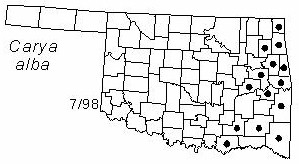Tree to 20 m (60 ft) tall and 50 cm (18 in) diameter, with rounded crown. Bark hard and gray, becoming irregularly furrowed into narrow forking ridges on older trunks and branches. Twigs thick, brown,hairy, with large half-round leaf scars. The single terminal bud is usually very large, and is covered by overlapping gray-hairy scales. Leaves alternate, pinnately compound, 20-50 cm (8-20 in) long, with a hairy rachis. Leaflets 7 or 9, elliptical or lanceolate, 5-20 cm (2-8 in) long, acuminate, finely serrate, shiny dark green above, paler and densely hairy below, usually gland-dotted and aromatic. Flowers catkins appearing in the early Spring. Fruits elliptical or pear-shaped, 4-5 cm (1.6-2 in) long, with a thick husk splitting to release a single large thick-shelled edible seed.
Distribution: The species is native to about the eastern 1/2 of the United States.
Habitat: oak-hickory and oak-pine forests
NWI status: none
Comment: The nuts of all the hickories are important food for wildlife, especially squirrels. The wood is hard, heavy, and strong and is used for tool handles, ladders, and other specialty items. This and other hickories are used for barbecue and other smoked meats. Carya is the ancient Greek name for walnut; alba refers to the light-colored wood; tomentosa refers to the hairy leaves.
Distribution in Oklahoma: 
BACK
NEXT
RETURN TO INDEX
Last update: 9/8/99
 Go to Oklahoma Biological Survey Home Page
Go to Oklahoma Biological Survey Home Page
 Disclaimer
Disclaimer